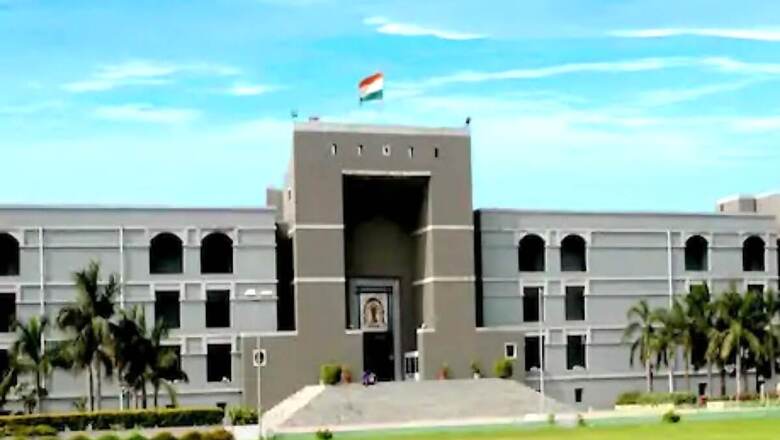
views
The Gujarat High Court became the first court to livestream judicial proceedings on 26 October, through its YouTube channel. In less than 40 hours, the stream recording the proceedings before Division Bench no 1 (comprising of Chief Justice Vikram Nath and Justice JB Pardiwala) was viewed 106,342 times and was ‘liked’ 3,900 times.
In the press release issued, the court said that the livestream was on a trial basis, with the modalities being considered. Subsequently, the proceedings of 27 October were also live-streamed.
Following the Gujarat High Court’s initiative, Attorney General for India, KK Venugopal also urged the Supreme Court of India to consider livestream its proceedings, in light of the judgment in Swapnil Tripathi v. Secretary-General, Supreme Court of India (Swapnil Tripathi). In response, the Chief Justice of India SA Bobde noted that he is in favor of livestreaming on a principle basis but adding that it is sensitive to the practicalities that surround it.
While the initiative to livestream court proceedings has been welcomed, as is visible through the commendations it has received, and statistically from the initial response on YouTube, certain questions on technological feasibility and potential misuse remain. Is the Indian ‘audience’ ready to adopt livestreaming of judicial proceedings on a larger scale?
Pandemic forced to Adapt Technology
The Covid-19 pandemic has proven to be a litmus test for Indian courts in terms of adopting and adapting with technology, while making courts more accessible to everyone. It was proven to be a blessing in disguise, as courts have been forced to undertake video conferencing as an alternative to regular open-court hearing, thereby reducing the latent inertia and reservations that judges and lawyers had towards virtual proceedings.
E-filings have been permitted in several courts across the country, which have eased the administrative process for litigants and lawyers. Earlier, while the affidavits and documents would need to be couriered by a litigant from his/her remote location to the lawyer’s office, now the litigant only needs to scan the documents and send them online. This has eased the burden and helped streamline e-filing procedures.
Virtual hearings have been adopted across a large number of courts, with several High Courts and District Courts issuing standard operating procedures (SOPs) to regulate the manner in which these proceedings should be conducted.
With these SOPs and through trial-and-error, over time, the manner of the proceedings also becomes more efficient. The only question that remains is to determine whether this technological advancement can also be utilized to make court proceedings accessible to all through live streams or recordings.
Overview of decision in Swapnil Tripathi Case
While the issue of videoconferencing as an effective tool for dispute resolution was mired in controversy, the Supreme Court had the occasion to consider the question of livestreaming of regular open court proceedings in Swapnil Tripathi. The question that arose before the SC was whether the case proceedings, which were of “constitutional importance having an impact on the public at large or a large number of people”, could be livestreamed in a manner which would be easily accessible for public viewing. The Court considered the position on livestreaming in several other jurisdictions, and observed that the requirements of an open court and public access to justice could be traced to Articles 19(1)(a) and 21 of the Constitution.
Notably, while the majority judgment held that the Supreme Court Rules, 2013 would have to be suitably amended in order to provide for a regulatory framework; the concurring judgment of Justice Chandrachud went a step further to provide the requirements of such livestreaming procedures.
The concurring judgment provided a list of matters that would be excluded from livestreaming, such as matrimonial disputes, cases involving sensitive issues as in the nature of sexual assault, cases concerning juveniles, etc. Furthermore, it also provided the manner of conducting livestreaming, including the requirement that livestreaming should be done with a delay of two minutes, in order to stop any broadcast that is embarrassing or prevents administration of justice. It also laid down the technical specifications for livestreaming, including the fact that discussions among judges on the Bench, or instructions given to an administrative staff, or notes taken down by the judge, should not be filmed.
However, what is important to note is that both the majority as well as concurring judgment held that the Supreme Court would have exclusive IP rights, including copyright over the broadcast. Therefore, any reproduction, re-broadcasting, transmission, publication, re-publication, copying, storage and/or modification of any part(s) of the original broadcast of court proceedings would stand prohibited.
Livestreaming around the world
The High Court of Australia publishes audio-visual recordings of full court hearings heard in Canberra, on its website. The terms of use provide that the audio-visual material does not constitute the official record of the Court. This appears to be a measure adopted by the court to prevent misinterpretation of the recordings.
Unlike the live streaming adopted by the Gujarat High Court where the proceedings in every matter called for the day are recorded, the High Court of Australia publishes recordings on a case-by-case basis, and the content of the recordings mostly comprise of the submissions made by the parties. The content of the coverage is vetted and recordings are posted usually within a day or two of the hearing.
Whereas, the Brazilian Supreme Court allows live video and audio broadcast of court proceedings, including the deliberations and voting process undertaken by the judges in court. The proceedings are streamed through a television channel and radio channel that are managed by the court.
The Canadian Supreme Court allows broadcast and livestreaming of its proceedings. Every archived webcast is accompanied by a summary of the proceeding and also has options to hear the proceedings in French or English. The live stream and recorded archives are available on the Cable Public Affairs Channel (CPAC), which also broadcasts proceedings in houses of parliament. The CPAC describes itself as “Canada’s only privately-owned, commercial free, not for profit, bilingual licensed television service.”
In UK, the Supreme Court has issued a practice note which allows for hearings to be live streamed on its own website with a delay of around one minute and also has a You tube channel which shows selected broadcasts from the livestream. However, the permission of the President and the Justices of the Supreme Court must be obtained on each occasion.
Recommendations and Challenges
Public accessibility is an avowed objective, which the SC has attempted to achieve through various means, including translation of judgments across several vernacular languages. Similarly, livestreaming is another step towards taking advantage of increased technological literacy to make proceedings more accessible to the public.
The Gujarat High Court’s livestream resembled, in principle, the procedure adopted by the Brazilian Supreme Court, where proceedings are streamed through a television channel and radio channel. The Brazilian model goes a step further by managing the channels itself. This gives the court greater autonomy over its archives and management of its proceedings. However, having different channels for different courts across the country poses a logistical hurdle in terms of resources to set up and manage the channel. The first step to overcoming this hurdle would be establishing committees set up by the respective High Courts in each state to look into the feasibility of the same.
The livestreaming models adopted in Canada and Australia provide for recordings of proceedings on a case-by-case basis. This approach provides a higher benefit in terms of the educative value. The Canadian Supreme Court also streams its proceedings through a pre-established channel, which also broadcasts proceedings in the Houses of Parliament. Canadian model may be a better suited model for Indian courts to tailor and adopt.
The courts should also consider a mechanism by which they can collate the arguments in each matter, so as to create a single, consolidated recording covering the substantive hearing of that particular matter. This will greatly enhance the accessibility and educational value of the recording, as any person interested in proceedings of a particular matter heard over several days, will not be required to go through the cumbersome task of reviewing several hours of live-stream comprising all daily matters taken-up by the court.
As already identified in Swapnil Tripathi, the court should retain IP rights over the live-stream. However, the court may consider licensing its rights for the purpose of streaming through third-party providers or even facilitating comprehensive compilations of the recordings by legal reporters. The court may add a further clarification that the proceedings should not be misrepresented by way of portraying incomplete or piecemeal parts of the live-stream, to ensure that people do not misuse the footage.
In order to regulate, several measures such as a delay between the actual proceeding and the broadcast would enable the court to regulate the manner in which the proceeding is streamed, including any embarrassing footage or any footage that may obstruct the administration of justice. Further, any discussions between judges may also be muted.
In cases where there are concerns with respect to privacy of the parties in certain criminal proceedings involving rape, sexual assault, juveniles, etc. It may be prudent to obtain the consent of these parties prior to live-streaming or recording proceedings in their matters. Livestreaming should make justice accessible but should be limited to the extent that it compromises the identity or sensitive nature of parties / proceedings in certain cases.
The courts could consider turning off comments, live chat, like and dislike options in the YouTube broadcast. The reason is that the live-streams should not become a site for hate-mongering or trolling, especially when sensitive cases are being heard by the court.
Helps in public literacy, transparency
The pandemic has already given us an impetus to make the shift towards virtual proceedings and e-filings. To take this further, livestreaming would only help the courts in realizing the need for public accessibility and public literacy about court judgments. The recent initiative of Livestreaming of proceedings by Gujarat High Court has been a welcome move and Indian courts may consider to adopt a model more accessible to the public.
In an article titled ‘Television and Judicial Behavior: Lessons from the Brazilian Supreme Court’, Lopes notes that televising court proceedings has led to a drastic increase in transparency amongst judges in the Brazilian Supreme Court. An added benefit would be to demonstrate that justice is not only done but ‘seen to be done’ as well. Maybe, streamlined exposure to sunlight proves to be the best disinfectant after all.
Disclaimer: Raveena Sethia is an associate with the Competition Law Practice at Shardul Amarchand Mangaldas & Co. Shreeyash Uday Lalit is a practising lawyer in the Supreme Court of India and Delhi High Court. Both authors completed their LLMs from the University of Cambridge in 2018.
Read all the Latest News and Breaking News here

















Comments
0 comment